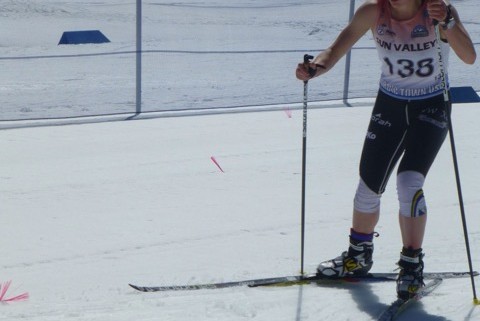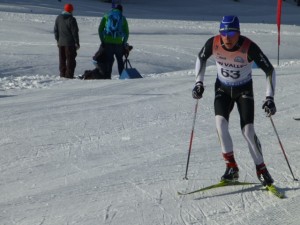Rest Up, Eat Up, Drink Up
Emily Blackmer, Far West Elite XC Ski Team member and Silver Sage Sports and Fitness Lab sponsored athlete shares practical fueling lessons from her Spring Series race campaign. Opening photo, Emily Blackmer throwing it down in the 30k. photo credit Jeff Fereday.
The end of March brought the Elite Team to Sun Valley, Idaho for Spring Series, the final races of the SuperTour circuit. At this point in the season—after 5 months of racing and nearly 11 months of training—every racer is dreaming of spring break, lying on the beach, visiting family, adventuring, sleeping in for a week straight. Pretty much anything but ski racing, really. And yet Spring Series is also the most competitive domestic race series of the year. The US Ski Team flies in after the close of the World Cup season, the top domestic racers return from trips to Europe, the top collegiate skiers (American and European) strut their stuff, Canadians venture south, biathletes switch sports—EVERYONE goes to Spring Series.
Wyatt Fereday moving well in the 50k, photo credit Jeff Fereday.
In these circumstances, it turns out that the best way to prepare for the most competitive races of the year is to not prepare very much at all. Everyone is tired, everyone is burnt (or burning) out, but not everyone is rested. Since I wasn’t traveling, or even racing, for over a month prior to Spring Series, I used the opportunity to take a physical and mental break. I kept up training for several weeks, but in the 10 days before going to Idaho, I did very little: two short interval sessions to keep me sharp, some easy runs to keep my body moving, and some easy core strength. No matter what I did in that short time period, I wasn’t going to get fitter or faster. However, I could recover. And I did! When we got to Idaho, I was psyched to race and posted some of my strongest results of the season against a deep field.
For me, by far the hardest race of Spring Series was Distance National Championships, 30k for women and 50k for men. The men skied at 9 AM, in rock hard, icy, very fast conditions. The winning time was 1:57:06—for 50 kilometers! That’s absurdly fast. But for the women’s race, the sun came out, the day heated up, and the snow turned from bulletproof into a disastrous combination of slush and dry snow just beginning to transform—about the slowest possible snow conditions. Add a high near 60°F and we knew we were in for a brutal race. I had prepared for this: eaten lots of food in the days prior, consumed more sports drink than my dentist would advise, stripped to my sports bra and a bib for the race. But still I was caught off guard.
The manta for long distance races is “Feed Early, Feed Often,” to make sure the body receives enough fuel during a long, hard effort. I know this rule well, but for some reason I failed to follow it. I took feeds often during the 30k, but in the heat my body was more interested in water than Gatorade. As a result, I wasn’t ingesting the calories or the electrolytes I needed. Thankfully, my teammates were looking out for me. The boys noticed that I was only drinking water and decided to take action. Just around halfway through, when I was beginning to really hurt, one of them shoved a Gu into my hand. “Take it for the road!” he said. Luckily I had the presence of mind to realize that I should do as I was told, and I forced the gooey Gu down my throat. In retrospect, I needed it—BADLY. I’m sure I narrowly missed an epic bonk. Taking that feed didn’t stop the race from being the hardest, longest, slowest race I’ve ever done—but it may have enabled me to finish. On some days, that is a big accomplish in and of itself.




